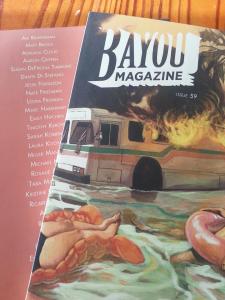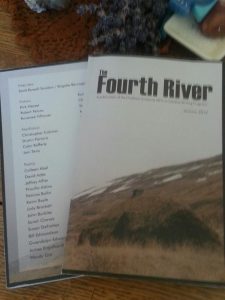It’s been a busy summer, full of zucchinis, backyard barbeques, and breezy bike rides. It’s also been a busy season for publications, and I thought I’d take a moment to round up some of the pieces I’ve had featured recently, along with the stories behind them.
1. Fear of Men (poetry)–HEArt Journal Online
When I answered a call for an online journal looking for poetry oriented toward social justice, I had no idea I’d be rubbing elbows with TERRANCE FREAKING HAYES. (Yes, that Terrance Hayes, winner of the National Book Award for Poetry.) But when the latest issue of HEArt Journal went live, I was just as blown away by the work of nearly everyone featured–including Tim Siebles, one of my longtime poetry heroes.
The response to my poem, “Fear of Men,” was even more overwhelming. People commented, they shared, they discussed deep stuff in connection with this little poem of mine. All told, “Fear of Men” has consistently been one of the top hits on the site, according to its lovely editor Leslie Mcilroy (who went so far as to drop a note to this effect).
This poem felt risky to write. Risky because I was wading out into charged territory. Risky because I was venturing into “politics” to say something intensely personal. Risky because it’s about my dad, my grandad, my husband. Risky because it’s about men and their relationship to violence.
More often than not, the writing life is a solitary one, precipitated on a vague hope of someday, somehow, touching someone with our work–a hope that feels increasingly abstract the longer we labor in the journeyman stage of this art. The response to this poem has been profoundly encouraging. This is the risk, and the reward. This is what I’m about.
2. Spin (Fiction)–Bayou Magazine
Can we talk about Robin Baudier? This associate editor at Bayou Magazine fell for my weird little quantum love story and championed it from start to finish. Apparently, this story had existed in a sort of limbo at Bayou until she arrived on the scene. Not only did she push for its acceptance, she worked closely with me on editing it for publication.
As a professional editor myself, I feel quite qualified to say that Robin is top-notch. I’d worked this story over so many times at that point I couldn’t even imagine, say, introducing a new scene. But with Robin’s encouragement and guidance, I did, and I can honestly say the story is better for it.
I wrote the first draft of “Spin” when I was all of twenty, when I first became obsessed with the imaginative dimensions of the scientific paradigm. It went through innumerable drafts over the past fifteen years or so, and each time I thought it was done, but no journal would take it. (I’m sure the piece had been rejected at least twenty times. Though it did get me into grad school! =)
For this piece not only to have found a home in Bayou Magazine, but to have connected me with such an enthusiastic editor–maybe I should just come out and say it, a fan–has shown me this: the odd sort of fiction I produce may not be for everyone, but the people who like it really like it. And really, that’s all that matters.
Kurt Vonnegut advised us to write for one person. (“If you open a window and make love to the world, so to speak, your story will get pneumonia.”) As I write the rest of the stories in Omniscience–a collection of love stories about science–I wouldn’t be surprised if I found myself writing them for Robin Baudier.
(The linked title above goes to the audio recording I made for Bayou of “Spin.” If you’d rather read it, please consider purchasing the current issue.)
3. Gardener’s Refrain, Equinox (poetry)–About Place Journal
It seems I’ve been successful of late with publications that focus on place. This publication fits that category, but is gratifying in that it also focuses on spirituality–the latter being a subject most literary mags, in my experience, won’t touch. How gratifying, then, to have found About Place’s Earth, Spirit, Society issue.
The first poem is “Gardener’s Refrain,” which was inspired by my roots in farming and folk music. Both of my parents grew up on farms of one type or another, and both of them are fairly musical, but it was my mom who exposed me to the folk tradition growing up, and who encouraged me to take up the banjo.
The banjo, I’ve found, is a magical instrument. People all over, older people in particular, are amazed that I play it. And, like folk music itself, it has connected me with some great mentors, deeply in touch with the populist history of this country, and the progressive tradition at the heart of it. Among them is Warren Miller, an inveterate banjophile residing in Prescott, Arizona.
Warren finds old banjos on eBay; he buys them and fixes them up, and sometimes, according to his wife, he even sells them. His house is like a banjo gallery where you can play the art. He and another mentor of mine named J.B. Outrider (yes) conspired to give me a 1930 Weymann banjo, which I play to this day.
The second poem, “Equinox,” is one of many in which I’ve tried to say something about what Joseph Campbell might call the cycle of spiritual renewal–the way it’s available to us via rituals, holidays, and celebrations, when we allow ourselves to step outside of time and gaze upon the world the way we maybe did as kids. It’s trying to say what can’t be said, what lies beyond the reach of language. Which is something, I believe, only poetry can do.
4. Song for a city #3 (poetry)–Fourth River
Like “Gardener’s Refrain,” this poem hails from my first chapbook, Undreaming Babylon (which is currently making the rounds with various contests–wish me luck!) and like that poem, this is one of place. But while “Gardner’s Refrain” draws on my Midwestern roots, “Song for a city #3” is a love song to Portland, Oregon.
Portland is the first real city I have ever lived in. And it has been extraordinary, as a writer, to be swept up in what is happening here, in terms of literary life. This is a land of big trees, and we apprentice and journeymen writers are sheltered by giants: Ursula K. Le Guin, Chuck Palahniuk, Matthew Dickman, Lydia Yuknavitch, Brain Doyle, Kevin Sampsell, and Jean Auel, to name just a few. This poem imagines the way a city can become a kind of collective organism, constantly telling its story, constantly influencing itself.
You might have noticed that there’s no link from the titles above–that’s because these poems have found a home in a good old fashioned print publication, with no online equivalent. If you’re interested in reading the poem, please consider purchasing Issue #9 of Fourth River–it’s full of excellent place-based work.
Until next time,
Susan

